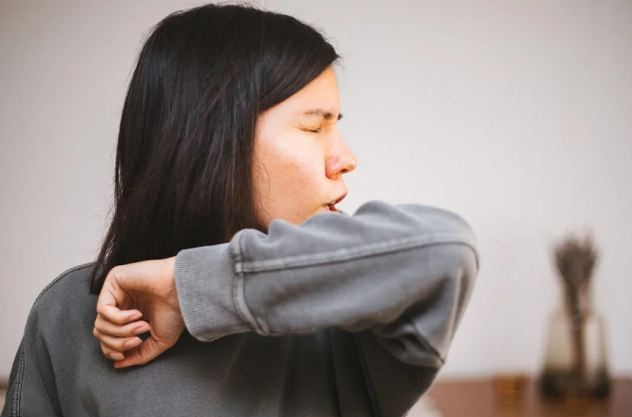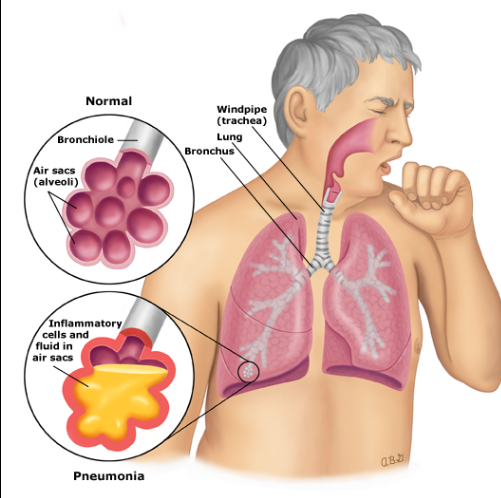Persistent coughing is a hallmark of this gradually worsening type of pneumonia, called Walking Pneumonia
Perhaps it ought to be known as “dragging pneumonia.” Although you don’t feel too bad, you have a persistent hacking cough and are extremely exhausted and weak. You might also be experiencing a mild fever. If these symptoms continue, it may be the cause. It’s a less severe type of bacterial pneumonia that’s usually treatable once you see a doctor.

Types of Walking Pneumonia
One unusual form of community-acquired bacterial pneumonia is. Based on where the infection is contracted, cases of pneumonia are classified into one of two groups. The term “community-acquired” refers to an infection that you contract on a regular basis, whether at work, school, or another public place. Conversely, pneumonia acquired in hospitals or other healthcare settings is typically not it.

Different kinds of pneumonia are caused by different kinds of bacteria, and they differ in severity and course of treatment. The medical definition of “walking pneumonia” is more specific, even though the term is occasionally used by the general public to refer to any milder form of pneumonia, including viral pneumonia. The mycoplasma bacteria is the cause of walking pneumonia. “Atypical” walking pneumonia is so named for multiple reasons. “People get sick quickly and have severe symptoms pretty acutely with classic kinds of bacterial pneumonia,” says Dr. David LaFon, an instructor at the University of Alabama at Birmingham’s division of pulmonary, allergy, and critical care medicine. Atypical pneumonia, commonly known as walking pneumonia, can occasionally present with a slightly delayed onset.They can sometimes cause a dry cough and a less severe presentation.”.

Causes
Walking pneumonia is caused by the Mycoplasma pneumoniae bacteria. About 2 million cases of M. pneumoniae infection occur each year, although the number of cases is likely underestimated, according to the Centers for Disease Control and Prevention. Walking pneumonia is a respiratory condition. One kind of respiratory illness is walking pneumonia. According to Dr. Laraine Washer, hospital epidemiologist for the University of Michigan Health System and associate professor of infectious diseases at the University of Michigan Medical School, “pneumonia has to get into the respiratory tract, so the portal of entry is through the mouth and nose.” It’s possible for someone to sneeze on you and for you to simply breathe it in, or it could land on your hands from the surroundings and enter your respiratory system. However, pneumonia is typically caused by a direct infection.” The most common age group for walking pneumonia to develop is under 40 years old. A few places that promote contagion are crowded offices, military barracks, college residence halls, and classrooms.

Symptoms
“I’m so tired of coughing.” When kids visit Cincinnati Children’s Hospital Medical Center’s Pediatric Primary Care Center with walking pneumonia, general pediatrician Dr. Nick DeBlasio typically hears that from them. These kids typically look fine, DeBlasio says: “They’re up and around, they’re walking—they seem to be in good health.” Because of that, parents often initially believe that their child’s cough is just caused by a cold. However, he adds, “What happens is the parents bring the kids in because they’re coughing so much.” Children affected are typically school-age. “Typically, we don’t see walking pneumonia, or mycoplasma pneumonia, until the kids are usually around 4 or 5,” DeBlasio says. “Usually, you don’t see that in infants.”

Diagnosis
To diagnose walking pneumonia, health care providers evaluate your symptoms, listen to your lungs and possibly order an imaging test. If you report having a cough that won’t go away, the ability to function, but feeling generally unwell with a gradual onset of symptoms, doctors will consider walking pneumonia as a possibility. The stethoscope exam helps doctors pinpoint your specific respiratory condition. “Usually, with a cold, the lungs are going to sound pretty clear,” DeBlasio says. “With more classic pneumonia, you tend to hear characteristic sounds more localized to one particular spot in the lungs. But with walking pneumonia, you just hear diffuse crackles all over the lungs, oftentimes on both sides.” Clinicians may or may not order a chest X-ray to provide further confirmation of walking pneumonia when you have persistent cold- or flu-type symptoms that aren’t resolving.

Treatment
Walking pneumonia is usually treated on an outpatient basis in a doctor’s office or clinic. Oral antibiotics are the standard treatment for walking pneumonia that doesn’t resolve on its own. Azithromycin (brand name Zithromax) is commonly prescribed. “Typically, we treat kids for five days,” DeBlasio says. “They can still be coughing for a couple more weeks.” Adults are also prescribed azithromycin or a similar antibiotic in the same class (macrolide antibiotics). As with kids, a shorter course of antibiotics is now recommended than previously.

Also read-Pneumonia : A Patient’s Guide To Pneumonia And Its Symptoms
images source: Google
Disclaimer: The opinions and suggestions expressed in this article are solely those of the individual analysts. These are not the opinions of HNN. For more, please consult with your doctor




































